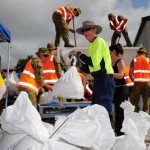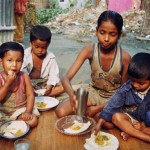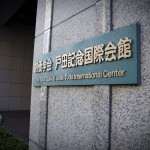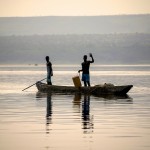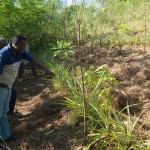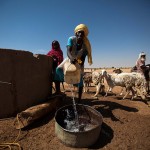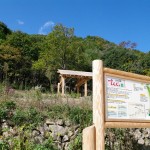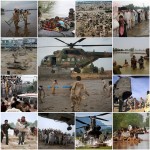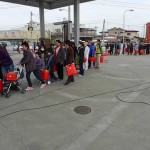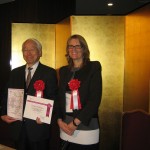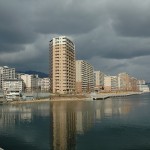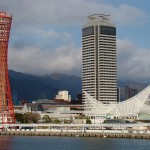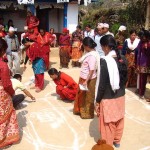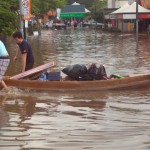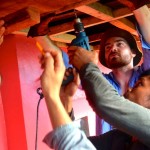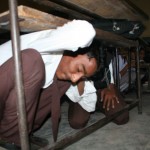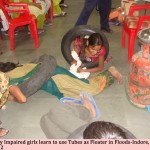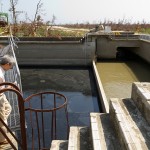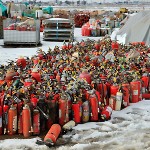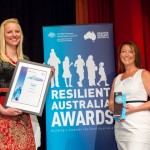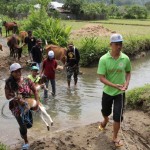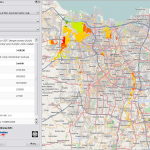
Celebrating the success of HFA

In the run-up to the World Conference, UNISDR called on countries, organizations and civil society to submit films celebrating their successful implementation of the Hyogo Framework for Action, and highlighting important issues for the post-2015 framework. The response was excellent and, to date, stories and films have been posted on this page. Click below on each of the five HFA priorities.
The videos will also be broadcast in the Auditorium of Sendai City Museum, opposite Sendai International Centre, over the course of of the World Conference. For the full broadcast schedule, click here.
1. National and local priority
| Title | Description | Location |
|
Creación de la Unidad Nacional para la Gestión del Riesgo de Desastres - UNGRD
Chapinero, Bogota, Colombia - one of 795 municipalities receiving financial support from the World Bank/GFDRR to formulate risk management strategies and incorporate DRM into the land use plans. |
Se creó una entidad pública de alto nivel en la estructura político-administrativa del Estado, con la capacidad de dirigir, orientar y coordinar las entidades públicas, privadas y comunitarias que conforman el Sistema Nacional de Gestión del Riesgo de Desastres, en la implementación de la política de Gestión del Riesgo de Desastres; a través del conocimiento y la reducción del riesgo y el manejo de desastres. |
Colombia |
|
Nigeria oil pipeline breaks: a disaster risk reduction approach |
The prevalence of oil pipeline vandalism in Nigeria has recently emerged as one of the veritable problems to human life and security. This documentary explores the causes of oil pipeline vandalism and its effect on the Nigerian state and describes briefly how the Nigerian Government introduced a structural intervention by implementing a disaster risk reduction approach to reducing the menace of oil pipeline explosions and related emergencies. |
Nigeria |
|
Integration of MISP into the disaster risk reduction and preparedness action plans of provincial/district disaster management authorities
International Planned Parenthood Federation (IPPF) Pakistan / by A. Zaidi |
The IPPF SPRINT project is advocacy for disaster risk reduction and inclusion of Minimum Initial Service Package and Sexual and Reproductive Health into the National Disaster Risk Reduction and Management policies and programmes of Government. |
Pakistan |
|
The making of district disaster management plans
The Brahmaputra river and its tributaries in northeast India nurture acres of lush paddy. But overfed by the rapidly melting glaciers of the Himalayas, and rains, the river often swells over during the monsoons releasing massive quantities of water which sweep off houses and raze crops. / Photo Credit: Dominique Feron EU/ECHO 2012. http://goo.gl/0A4vS3 |
The case study demonstrates how effectively the HFA 1 can lead to the incorporation of its five priorities at all levels. A policy initiative of India that made disaster risk reduction (DRR) and disaster management (DM) planning a national priority, has resulted in Assam State Disaster Management Authority (ASDMA) revamping its DM plans that lay special impetus on DRR into local (district) level developmental planning by conducting risk assessments (HFA Priority 2). |
India |
|
The Dutch Delta Programme
Pre 1970s dike workers and builders on a seadike at the village of Westkapelle, Zeeland / Ard Hesselink, Flickr - http://goo.gl/KBbbRF |
The Dutch Delta Programme: national flood risk management (FRM) implements strategies that aimed to protect the Netherlands against flooding, while anticipating climate change and socio-economic developments up to 2100. FRM is a three-layered approach that has been developed in which protection (against floods), prevention (damage) and disaster management (casualties) are integrated (“multi-layered safety”). |
Netherlands |
|
Rebuilding after Typhoon Haiyan
Workers rebuild communities destroyed by super typhoon Haiyan / ILO - Creative Commons Attribution -NonCommercial-NoDerivs 3.0 IGO License |
The Typhoon Haiyan Comprehensive Rehabilitation and Recovery Plan (CRRP) is the Philippine Government’s Plan to build back better, faster, and safer in the areas devastated areas by Typhoon Haiyan. In less than one year, the government produced the CRRP adopting the Cluster Framework Approach, which pursues a consultative and participatory process among national and local government agencies, the private sector, development partners, civil society organizations and communities. |
Philippines |
|
Typhoon Haiyan "Yolanda" Comprehensive Rehabilitation and Recovery Plan (video)
Workers rebuild communities destroyed by super typhoon Haiyan / ILO - Creative Commons Attribution -NonCommercial-NoDerivs 3.0 IGO License |
This video gives you an overview of the 8,000-page, 8-volume document containing 18,648 programmes, projects, and activities for the 171 cities and municipalities in 14 provinces across the 6 regions of the Yolanda corridor. The Yolanda CRRP was approved by the President on 29 October 2014. This is the government’s plan towards building back better, faster, and safer. (HFA Priority 1) |
Philippines |
|
Policy advocacy at national and communal levels
Indonesian women at community meeting to discuss village reconstruction / Nugroho Nurdikiawan Sunjoyo / Photo ID: NNS-ID013 World Bank |
Masyarakat Penanggulangan Bencana Indonesia (MPBI) started work on the HFA2 in 2012. We believe this kind of work should not be done only for the United Nations World Conference on Disaster Risk Reduction (WCDRR), but also to foster resilience to disasters, conflicts, crises, and for vulnerable communities and the people of Indonesia. |
Indonesia |
|
Iran's Activities on Disaster Risk Reduction of Schools (HFA 2005-2015)
A girl in primary school, Bandar Abbas. Iran / UNICEF Iran, Shehzad Noorani |
The Government of Iran has allocated more than 4.5 billion US$ between 2006 and 2014 in the renovation and retrofitting of schools, leading to resilient school infrastructure and an increase of students’ life safety from 33% in 2006 up to 67% in 2014. Such experience in mobilizing relevant budget for domestic safe school implementation can serve as role model for neighboring countries. |
Iran (Islamic Republic of) |
|
Strengthening inclusive DRR in the Dominican Republic
|
An interagency initiative implemented in the Dominican Republic during 2012-2014 has resulted in the strengthening of community and institutional disaster preparedness in Azua, while ensuring inclusion of groups with specific vulnerabilities, especially women, children, people of Haitian descent and people living with disabilities in disaster risk management (DRM) decision making and resilience building activities. There is evidence of more inclusive DRM action led by empowered local government authorities, many signed up to the Resilient Cities Campaign, who now championing resilience governance in this at-risk Caribbean country. |
Dominican Republic |
|
Integration of MISP into the Disaster Risk Reduction Action Plan of District and Provincial Government in Pakistan
|
The sexual and reproductive health programme in crisis and post-crisis situations addresses all stages of the emergency management cycle. It ensures timely access for crisis-affected populations to life saving sexual and reproductive health services as outlined in the Minimum Initial Services Package (MISP). It creates an enabling environment through advocacy with key stakeholders, puts measures for disaster risk reduction in place and establishes mechanisms to build country capacities for emergency preparedness. Read more |
Pakistan |
|
Hyogo passes on memories and lessons of Great Hanshin-Awaji Earthquake
|
Hyogo Prefecture has designated January 17 as the annual “Hyogo Safety Day”. It is an event that passes on memories and lessons learned from the 1995 Great Hanshin-Awaji Earthquake. On the day, Hyogo holds a memorial ceremony for the earthquake victims while organizing a memorial walk in which participants walk through disaster-affected areas to revisit the earthquake experience where people faced total disruption of public transport service. In addition, Hyogo has been supporting citizens with various disaster preparedness and disaster risk reduction initiatives that befit Hyogo Safety Day. Read more |
Japan |
|
Hyogo Prefecture sets example as it strengthens disaster management The Hyogo International Association's disaster preparation guidebook - www.japantimes.co.jp |
Based on the lessons learned from the chaotic experience of Japan just after the Great Hanshin-Awaji Earthquake, Japanese local governments have enhanced their disaster management systems significantly in terms of strengthening the disaster reduction framework and disaster preparedness facilities. Read more |
Japan |
|
Sendai City builds safety – resilience at all levels |
“We have supported the activities of volunteer disaster-prevention organizations based in neighborhood associations, which are the foundation of communities. In addition, we have promoted disaster-prevention measures which enable city government and local communities to work together.“ Read more |
Japan |
|
The Great Hanshin-Awaji Earthquake Reconstruction Fund
|
The Great Hanshin-Awaji Earthquake Reconstruction Fund was established in April 1995 with 900 billion yen in funds to drive recovery for disaster-affected areas. From its inception until 2007, this fund spent approximately 360 billion yen on projects to assist housing, living, industry and education recovery in disaster-affected areas. Read more |
Japan |
|
Local community rebuilding in Hyogo Prefecture |
In the aftermath of the Great Hanshin-Awaji Earthquake, as part of its reconstruction efforts, the Hyogo Prefectural Government provided “bases” for community activities such as assembly halls, and also established a “key person” system for connecting residents to both local citizens and outside support. Read more |
Japan |
|
Promotion of a public-private partnership
|
The Hyogo Prefectural government implemented a recovery initiative for the Great Hanshin-Awaji Earthquake, which deals with local community challenges in collaboration with various stakeholders such as companies, related-organizations, and volunteers, while bringing the proactive effort of citizens into the heart of the initiative. Read more |
Japan |
|
Implementing the MISP for Reproductive Health in the Aftermath of the Zamboanga City Crisis Badjao smile. Zamboanga City crisis/ jeffpsj.blogspot.com/
|
The SPRINT initiative is a Sexual and Reproductive Health Programme in Crisis and Post-Crisis Situations. SPRINT works to ensure access to essential lifesaving services for women, men and children in times of crises, a time when services are most needed yet are not prioritized or recognized by key humanitarian responders. Implementation of the Minimum Initial Services Package (MISP) is not optional. It is an international standard of care that should be implemented at the onset of every crisis. Read more |
Philippines |
|
"Like our ancestors, if we have the heart, we can do it"
|
The Pacific has forged ahead with innovative institutional arrangements to keep the vulnerable region on the front foot in its efforts to reduce disaster risk and adapt to climate change. Read here how Vanuatu has established a Ministry for Planning and Climate Change Adaptation and how the Cook Islands is using its national budget to ‘hinge and hook’ climate finance. Read more |
Pacific Islands |
|
Lebanon embarks on regional first with disaster risk plan
|
has a lot on its plate but that has not stopped it from being a leading light in the Arab world terms of disaster risk reduction and being the first country in the region that has adopted an overarching national strategy that balances corrective, prospective and compensatory action. Read more |
Lebanon |
|
HFA helps Mongolia reduce disaster deaths
|
the HFA, Mongolia has integrated disparate departments into one National Emergency Management Agency, with the commitment to treat disaster risk reduction as a development issue. Read more |
Mongolia |
|
HFA helps Armenia reduce risk
|
Minister of Emergency Situations, Armen Yeritsyan, has praised the for inspiring “significant progress” in his country’s efforts to reduce disaster risk, including mainstreaming of DRR in government plans and policies. Read more |
Armenia |
2. Risk assessment
| Title | Description | Location |
|
How a small Samar town survived deadly storm surges
The purok, a smaller unit in villages in Daram, serves as a support network for residents, helping survivors like the Gudines family to pick up the pieces after the disaster/ Photo by Voltaire Tupaz/Rappler |
A coastal town in Samar province successfully weathers Typhoon Ruby by capitalizing on organized response as well as on timely, specific and localized early warning information. |
Philippines |
|
Flood Early Warning System in Assam: a mechanism for effective disaster risk reduction
Waiting for assistance in the floods, Assam, India / by OXFAM 2012 |
Flood Early Warning System (FLEWS) is a system by which flood induced hazards can be minimized and prevented. Currently different organizations are working on flood forecasting and early warning at national, continental and global scale. |
India |
|
Remote sensing and GIS for flood hazard management
Families take boats to flooded villages, Mehran Town, Dadu District, Sindh, Pakistan / Photo: Caroline Gluck/Oxfam |
This paper describes the application of remote sensing (RS) and geographical information systems (GIS) in identifying flood hazard zones and flood shelters Sindh Province, Pakistan, and is therefore an important tool for planners and decision makers. |
Pakistan |
|
How Sorsogon prepared for Typhoon Glenda
Typhoon Glenda destroyed houses and other infrastructures in Sorsogon. |
When Typhoon Glenda (internationally known as Rammasun) made landfall in the Philippines last July 2014, vulnerable communities in Sorsogon were prepared for it as they had disaster preparedness and response initiatives in place since 2011, thanks to the WFP and USAID/OFDA. |
Philippines |
|
Integration of Hospital Safety Index in Health System of Iran |
In line with the 2008-2009 UNISDR-WHO Global Campaign on Hospitals Safe from Disaster, WHO developed the Hospital Safety Index (HSI). Accordingly, Iran’s Ministry of Health and Medical Education (MoHME) in collaboration with Tehran University of Medical Sciences initiated a national program to integrate HSI into the health system. As a first step, the HSI was translated into Farsi and adapted to Iran’s situation as Farsi HSI (FHSI). |
Iran (Islamic Republic of) |
|
Development of a disaster information delivery system
|
Hyogo Prefectural Government (Hyogo) continuously releases real-time information on river water and rainfall levels to the public via the Internet and TV. Moreover, Hyogo and its municipal governments use the ‘Phoenix Disaster Management System’ to share information on river water level forecasts, along with SMS and email to send emergency information about earthquakes, tsunami, extreme weather and evacuation recommendations/instructions. In addition, Hyogo is equipped with flood prevention systems. Specifically for rivers with recreational water parks, if the water levels of these rivers rise rapidly due to rainfall, Hyogo has established circulating alarm lights, integrated with flood alerts/ warnings. |
Japan |
|
A metrics system for disaster risk management in Iran’s health system Woman receives medical attention after Iran Bushehr Earthquake 2013 / Mohammad Fatemi / EPA
|
In line with the Hyogo Framework for Action (HFA) Priority Action 2, Iran’s health system has developed and institutionalized a metrics system for disaster risk management that provides policymakers with annual qualitative information on indicators. This system has expanded throughout Iran and includes indicators, measurement tools, and protocols for data collection, analysis, reporting, and feedback targeting hospitals, primary healthcare facilities, and households. Read more |
Iran (Islamic Republic of) |
|
Building resilience in South Australia
|
Some natural events are unforeseen and the resultant damage is serious and unavoidable, but this is not the case in many of the most severe events. Many communities experience repeated disruptions from natural disasters, and the effects of these events could be minimised through better risk management, planning and prevention. However, effective management of disaster risk is heavily reliant on accurate and accessible information about natural hazards. To improve the quality and accessibility of risk information South Australia has developed the Zone Emergency Risk Management System (ZERMS) Project to assess disaster risk from multiple hazards. Read more |
Australia |
|
Measuring community resilience in times of crisis Social Inclusion for Resilience / UNISDR / Petra Finer |
The Community Disaster Resilience Scorecard Toolkit is a tool helping Australian policy makers, local authorities, emergency planners, and community groups to measure community resilience and to set priorities and progress emergency and disaster management plans suited to their situation. Read More |
Australia |
|
Evacuation saves whole island from Typhoon Haiyan
|
The prompt evacuation of 1,000 people from a tiny island that had all 500 houses destroyed by Typhoon Haiyan in November 2013, in Philippines, saved the entire population. The hero of the hour, UNISDR role model former mayor Al Arquillano, modestly summed up the experience: “It just shows preparedness pays.” Read more |
San Fernando Municipality, |
|
Farmers reap fruits of risk management
|
Beleagured papaya farmers in Fiji that were pushed to near bankruptcy in Cyclone Evan in 2012 have reassessed their disaster risk and as a result have changed their agriculture practices to build a more resilient business sector. This shift includes production being moved from traditional crop heartlands; budgets that include contingency for disasters, & planting on smaller blocks and on a more regular basis. Read more | Fiji |
|
Early warning helped minimize loss of lives in Orissa
|
The state of Orissa in India is inherently vulnerable to disasters due to its 480-km wide coastline. However, this risk was only given proper attention after it lost thousands of lives to a super cyclone in 1999. Watch how the HFA has helped the state of Orissa build a more resilient community through efficient early warning and disaster preparedness. Learn more | India |
|
Early warning once again saved lives in India
|
India has again emerged as a global example of early warning, early action with the timely evacuation of up to 400,000 people ahead of Cyclone Hudhud. Its strong track record of converting past lessons into better preparedness provides an important reference as global consultations progress to forge a post-2015 framework for disaster risk reduction. Learn more | India |
3. Knowledge and Education
|
"Puentes de la Esperanza y la Prosperidad” como respuesta en situaciones y/o zonas de emergencia
Volcán nevado del Huila - B&W / by Joz3.69 - Flickr Creative Commons |
Prestar asistencia técnica, logística y operativa a comunidades indígenas y campesinas en situaciones y/o zonas de emergencia, facilitando que los afectados se organicen y trabajen alrededor de la construcción de sus propios puentes peatonales, mejorando integralmente su entorno y calidad de vida, en el marco de los procesos de manejo de desastres, mitigación y reducción del riesgo y recuperación de zonas afectadas. |
Colombia |
|
Youth driving change
Youth Workshop, NIMS School, Sharjah UAE |
We, children and youth, are the future generations and need to be a part of the dialogue for a sustainable future, which also includes our voices in the implementation of the Hyogo Framework for Action, and a special focus on building disaster resilience for children and youth. |
United Arab Emirates |
|
Integrating early warning response capabilities and enhancing disaster resilience in the United Arab Emirates
Regional Workshop to Advance Disaster Risk Reduction in the Arab region 2012 / UNISDR |
Early warning (EW) is an essential element in disaster mitigation as it contributes to flexibility, reduces danger and protects the country's economy. |
United Arab Emirates |
|
Blog From Pakistan—A Lesson In Resilience
During her recent visit to Pakistan, WFP Executive Director Ertharin Cousin met with mothers at a family-nutrition centre in Kalam, a town located in the disaster-prone Swat Valley. Copyright: WFP/Amjad Jamal |
On her recent visit to Pakistan, WFP Executive Director Ertharin Cousin travelled to the Swat Valley, where breath-taking mountain views belie the humanitarian toll of natural disasters and conflict in neighbouring Afghanistan. In her latest blog from the field, Cousin describes how families are learning to protect themselves from hunger as they rebuild their lives. |
Pakistan |
|
Training needs assessment on DRR, CCA and integration
Disaster risk reduction training in Assam / EC Photo |
Assam State Disaster Management Authority (ASDMA) underwent a systematic in depth assessment of training needs in 2007 that was followed by step-by-step implementation of different capacity building actions for more than 5 years. ASDMA then moved ahead with another training needs assessment (TNA) (2013-2014) that focused on integration of disaster risk reduction (DRR) and climate change adaptation (CCA). |
India |
|
Ponte Alerta - Building resilience in the Dominican Republic through media and communication
Health promoters working under the project "Emergency response and early recovery for the most vulnerable people affected by Hurricane Sandy in the Dominican Republic" / by Carlos Arenas López/UNISDR |
An interagency initiative implemented in the Dominican Republic (2012-2014) has resulted in the strengthening of community resilience through innovative media and communication initiatives that have targeted at-risk groups -- particularly women, children, people of Haitian descent and persons living with disabilities. This has resulted in more inclusive disaster risk management action led by empowered vulnerable groups in this at-risk Caribbean country. |
Dominican Republic |
|
Mainstreaming disaster risk management into academia
Nepalese firemen participating in a disaster drill / by UNDP Nepal |
Mainstreaming disaster risk management (DRM) into academic curricula is the key to foster the knowledge to build risk resilient society. Tribhuvan University, Central Department of Environmental Science (TU-CDES) has developed the 100 Marks Disaster Risk Management course in its Master's Degree Programme in Environmental Science. |
Nepal |
|
Disaster Risk Management- Knowledge Management Centre
Emergency response simulation in Nepal. Photo: Deepak K.C., UNDP Nepal |
Access to of all kinds of disaster risk management (DRM) materials via a single hub is a unique way to disseminate and foster knowledge for better preparation. |
Nepal |
|
Achieving Lari-Levels of Resilience for Self-Reliant Communities
Clean water and flood-resistant shelter - |
Community resilience through women-centered approaches for early warning systems, relevant knowledge, information and training, integrated approaches targeting the Millennium Development Goals, zero-carbon DRR- compliant self built structures, alternative livelihoods etc. |
Pakistan |
|
Remote Islands of Indonesia advance DRR through universities, school teachers
Happy Kids in Payo Village, Jailolo, North Halmahera, Maluku Indonesia / Prayudi Hartono Flickr Creative Commons |
Small and remote islands are often the bottom priority in advancing disaster risk reduction, even though their risks are similar or even higher. Universities and schoolteachers in eastern Indonesian provinces have actively been engaged in reducing risks in remote and poverty-ridden areas. Collaborations by multi stakeholders can speed up the efforts for resilient communities. |
Indonesia |
|
Training needs assessment on disaster risk reduction, climate change adaptation and integration
Climate change has resulted in an extreme dry spell that has ruined the tea crops in Assam / by 350.org |
In 2007 the Assam State Disaster Management Authority (ASDMA) carried out in an depth training needs assessment (TNA) that were followed by step-by-step. |
India |
|
For a Glass of Water - supporting the human right to water
For a Glass of Water /Facebook Page |
'For Glass of Water' is an awareness and participatory campaign that has a global reach. The goal is to promote people’s participation to spread the importance of accessing natural resources (treated water in particular) and to bring to light the difficulties that the lack of water causes daily to women as essential agents in the management of this resource. |
El Salvador |
|
Urban Disaster Preparedness: Guwahati City
Guwahati / by Rituraj Bhuyan - Flickr Creative Commons - http://goo.gl/7R4YkW |
The Case study highlights the affirmative and innovative efforts of the Assam State Disaster Management Authority (ASDMA) to increase the seismic safety of citizens and schools in order to prevent damage and to protect students from injury or loss of life in hospitals as the hospital buildings remain occupied round the clock by a high percentage of immobile and vulnerable occupants. |
India |
|
Strengthening institutional capacity: a case of school safety trainings in Assam
Awareness raising by ASDMA /ASDMA |
A capacity building initiative on Disaster Risk Reduction and School Safety by Assam State Disaster Management Authority (ASDMA), one of the most vibrant state authorities in India, is a path breaking, innovative and first of its kind in South Asia. This three-day programme is designed to inform, sensitise and train school teachers across Assam state on disaster risk reduction (DRR) tools and mythology; thereby transferring knowledge to local communities. This massive three-year long exercise has covered 25 districts, 2,617 Schools, 3,606 teachers and 1,928 children including 1,024 girls |
India |
|
Internationalisation and disaster prevention
Disaster-zone foreigners feeling linguistic squeeze - Japan Times online / Nemo's Great Uncle - Flickr Commons - http://goo.gl/AL3INm |
Before the Great East Japan Earthquake (GEJE) Sendai was creating multilingual disaster-prevention awareness tools and holding disaster-prevention classes with local residents and schools to raise disaster-prevention awareness among foreigners. |
Japan |
|
Una experiencia piloto en la ciudad de Baños de Agua Santa en Ecuador
Tungurahua, Ecuador |
El proyecto desarrollado por la Secretaría Técnica para la Gestión Inclusiva en Discapacidades de la Vicepresidencia de la República del Ecuador en la ciudad de Baños de Agua Santa, promueve la incorporación de las necesidades de las personas con discapacidad en el proceso de la Gestión de Riesgos frente a emergencias y desastres, visibilizándoles en el análisis de riesgo, reducción, respuesta y recuperación; con el objetivo de lograr el desarrollo integral de la comunidad mediante la coordinación de acciones conjuntas con las personas con discapacidad, sus familias, la comunidad, los actores políticos e instituciones que trabajan en este ámbito. |
Ecuador |
|
Building disaster risk reduction capacity in Pakistan through academia
NUST Campus Islamabad-www.dostpakistan.pk |
Although the October 2005 earthquake played a significant role in creating general awareness about disasters in Pakistan, the 2010 floods in Nowshera district became a turning point. The Principal and the Faculty at the National University of Sciences and Technology (NUST) Risalpur Campus found it imperative to start working towards building capacity to reduce disaster risks in Pakistan. They started to offer a Masters in Disaster Management and the first batch of graduate students joined the programme in 2012. |
Pakistan |
|
Inclusive resilience through land use policies and actions
Castelmezzano, Province of Potenza, Italy, 26 Aug 2009 / commons.wikimedia.org |
The Province of Potenza adopted the Territorial Coordination Master Plan (TCP, 2013) that draws on local governmental proposals for the development of the provincial territory. It gives local actors and government tools for correct land use as well as disaster risk reduction, climate change adaptation and resilience policies. The Province is coordinating a wide resilience boosting process by providing 100 municipalities with tools and support to accompany a network approach that involves key local actors and communities in decision- making and implementation. |
Italy |
|
Campagne d’éducation pour le développement durable dans l’océan Indien
Children of SOS Village showing solidarity by taking |
Cette campagne d’éducation a pour objectif de sensibiliser de manière ludique les enfants de l’océan Indien sur des thématiques relatives au développement durable. La préparation aux catastrophes naturelles en est l’un des thèmes traités. |
Comores, La Réunion (France), Madagascar, Maurice, Seychelles |
|
School safety initiative where women lead
Disaster risk education in Assam, India / EC Photo - Flickr Creative Commons |
A story that highlights innovation driven change in attitudes, priorities and action for disaster risk reduction in school is being extracted here. It highlights how joint initiatives of Government, School and civil society can make a difference in ensuring that schools appear as safer heaven for the young ones, how they take the learnt messages of safety and risk reduction to their families and communities. This also highlights how women can lead localised DRR actions in their respective fields. |
India |
|
Children and young people build resilient communities in Pacific
(350 .org, Fanafuti, Tuvalu / Chris Chen - Flickr Creative Commons.) |
The children in the Pacific region, like in other parts of the world, are likely to experience increased impacts of climate change if left unattended. There is also potential for children to be adversely affected by climate change adaptation (CCA) and disaster risk reduction (DRR) policies that overlook their specific vulnerability and excludes them from discussions leading to the development of these policies. To address such urgent matters regarding children, the Foundation of the Peoples of the South Pacific International (FSPI), in partnership with Plan International Australia (PIA), is implementing a child-centred approach to climate change adaptation and disaster risk reduction that aims to reduce the vulnerability of children and their communities to the impacts of climate related disasters. | Fiji, Kiribati, Papua New Guinea, Solomon Islands, Tonga and Tuvalu. |
|
International disaster reduction cooperation by a local government
|
The Hyogo Prefectural Government provides disaster-recovery support based on our lessons to the world’s disaster-affected areas, by dispatching experts who have experienced the Great Hanshin-Awaji Earthquake. |
Japan |
|
The Great Hanshin-Awaji Earthquake verification and recommendations project
|
In the wake of the Great Hanshin-Awaji Earthquake (GHAE), the Hyogo Prefectural Government(Hyogo)summarised recovery reports one year after the disaster. In addition, the Great Hanshin-Awaji Earthquake Memorial Research Institute created a 10-volume publication on the disaster recovery progress. In the fifth year after the Earthquake, the Institute carried out the Earthquake Countermeasure Comprehensive International Review Project, while implementing the 10-Year Reconstruction Overall Verification and Recommendations Project at the 10th anniversary of the earthquake. These projects summarised lessons learned from the GHAE while making recommendations on future disaster reduction. |
Japan |
|
Disaster prevention education in Hyogo |
Primary schools and junior high schools in Hyogo Prefecture have been promoting disaster prevention education to pass on the lessons learned from the Great Hanshin-Awaji Earthquake (GHAE) and to help citizens cope with various types of disasters. |
Japan |
|
Establishment of Disaster Reduction and Human Renovation Institution
|
In April 2002, with assistance from the national government, the Hyogo Prefectural Government (Hyogo) established the Disaster Reduction and Human Renovation Institution (DRI). Its mission is to pass on the experience and lessons from the Great Hanshin-Awaji Earthquake (GHAE) to future generations and disseminate knowledge for disaster prevention and disaster risk reduction based on the disaster experience to Japan and the world. In addition to gathering, preserving and exhibiting materials related to the GHAE, DRI is engaged in comprehensive and practical research activities about disaster reduction, with dedicated researchers working for the institution, while providing disaster management training to local government officers nationwide. |
Japan |
|
Helping disaster victims find something to live for
|
For disaster victims who had lost their homes and relationships with other persons due to the Great Hanshin-Awaji Earthquake (GHAE), the Hyogo Prefectural Government (Hyogo) prepared a structure for disaster victims to have some “role” to live for. These projects include production/sales of hand-made items, various learning courses, and volunteer group formation support. |
Japan |
|
Empowerment of community and local disaster response and management capability
|
The Hyogo Prefectural Government (Hyogo) increased the ratio of organized community-based disaster prevention organisations (from 27.4% in 1995 to 94.9% in 2013) by providing rescue equipment to each community and encouraging communities to make use of the equipment for disaster prevention drills. In an effort to encourage the activities of disaster prevention organisations, Hyogo established a community leader development programme called the “Hyogo Disaster Management Leader Training Course.” In addition, it launched the “Hyogo Disaster Management Special Promoters System,” which is a system designed to dispatch specialists to teach disaster prevention activities to local communities. |
Japan |
|
A structure to achieve creative reconstruction: gender in reconstruction
|
The Hyogo Prefectural Government’s (Hyogo) reconstruction initiatives after the Great Hanshin-Awaji Earthquake (GHAE) were based on the stated philosophy of male-female joint participation supported by the Hyogo Prefectural Gender Equality Promotion Center. These initiatives strove to promote female participation in the reconstruction programmes by encouraging female citizens to participate in decision-making opportunities and through relevant empowerment activities. |
Japan |
|
Preparation and release of hazard maps
|
Hyogo Prefectural Government (Hyogo) has been preparing “Regional Disaster Prevention Information (CG Hazard Maps),” which outline potential flooding areas (due to heavy rainfall, high tide, tsunami, reservoir burst), sediment disaster prone areas and anticipated seismic intensity distribution, along with the location of evacuation centers. In addition to making this information available on its official website, Hyogo has been providing this information to municipalities so that they can deliver disaster risk and hazard information to citizens. Read more | Japan |
|
Children of Nasau embark on a climate smart solution to combat rising sea levels
|
“We got started in Nasau by getting the children and youths to undergo an awareness workshop at their community hall. It was from this workshop that the children themselves identified eroding waterfronts as a real concern, and came up with the idea that planting mangroves would help address the problem.” (Watisoni Lalavanua, Project Officer, Foundation of Partners in Community Development Fiji. Read more |
Fiji |
|
Triple Zero Kids Challenge
|
The early acquaintance by primary school children with Australia’s Triple Zero (000) emergency call service can lead to saving lives. The “Triple Zero Kids’ Challenge”—an award-winning on-line animated safety game for primary school-aged children—is a fun way for children to learn about a serious issue. Read more |
Australia |
|
Australian emergency management knowledge hub
|
The Australian Emergency Management Knowledge Hub is an online resource for collaborative and interactive information and knowledge sharing in the Australian emergency management sector. Read more |
Australia |
|
Sendai women participate in local disaster prevention
October 9, 2012, Emiko Okuyama, Mayor of Sendai City (© The World Bank Group, Photo by Christopher Jue) |
In the times of disaster, it is easy for a variety of situations to arise in which women’s human rights are violated. In the Great East Japan Earthquake (2011), consideration for women’s needs was lacking at many evacuation centres, and conditions for women were harsh. It is important for women to participate in disaster prevention from the decision-making stage for such situations to improve. For this reason, we are undertaking initiatives to promote women’s participation in disaster-prevention activities in their communities. Read more |
Japan |
Collaboration between vulnerable people, healthcare professionals, and researchers enhances disaster response choices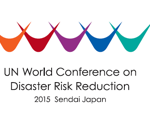
|
Communities that may experience airborne toxic plumes can help residents prepare to react immediately until danger has passed. “Expedient sheltering” requires reducing airflow into a safe room by employing readily available supplies. But disabled and other people with access or functional needs can have difficulty handling the normally recommended materials. Vulnerable people and researchers collaborated with healthcare professional support in this successful project to find easier-to-apply alternates. Read more |
United States |
|
Disaster resilience in multicultural Australia Australia's Multicultural Policy / Kate Lundy
|
As one of the most culturally and linguistically diverse (CALD) countries in the world, Australia recognises the importance of equal access to services and information for all people, regardless of their background. The Australian Emergency Management Institute (AEMI) works to build emergency management capability to engage with multicultural communities to address their needs in relation to dealing with disasters. Read more |
Australia |
|
Emergency Management Volunteer Leadership Training in Australia
|
Volunteers are at the front line of Australia’s disaster preparedness, response and recovery activities. In 2009, the Australian Emergency Management Institute (AEMI), in partnership with the Australian Emergency Management Volunteers Forum (AEMVF), developed a training program to meet the leadership needs of volunteers. Read more |
Australia |
|
Bank chief urges business to lend resilience wisdom |
Banking executive Adrian Hughes believes governments have a lot to learn from business in terms of the private sectors knowledge and innovation in bouncing back quickly. “We need to look at those businesses that have lasted a couple of generations and ask ourselves: ‘what are they doing and how can we learn from them’,” the Fiji-based financier said. Read more | Fiji |
|
School director pioneers safer learning for pupils |
Baiboonlamphun School, in Thailand, has 1,600 pupils and a school director – Mr Pachernwaat Srichai – who is a pioneer of safe learning: “In the past it has been suggested that parents in developing economies are not as concerned about school safety as those in developed countries but that is not the case.” Read more of how Thai school is showing an important way forward under Priority Area 3. Read more | Thailand |
|
Pakistan’s first DRR Masters graduates |
The faculty of Pakistan’s National University of Science and Technology Risalpur campus knew it was time to act when the 2010 floods devastated large swathes of their country directly affecting 20 million people. Read more | Pakistan |
4. Vulnerability Reduction
|
WFP Asia: Keys To Solving Hunger 3 (Climate Change Adaptation)
Bangladeshi children eating food / Photo Credit:WFP/Abdul Mannan |
Bangladesh | |
|
Non-structural safety assessments: a case of 15 hospitals in Assam
Hospital Inspection Assam / |
Assessing Hospital Safety describes the audit which was conducted in fifteen government and private hospitals in the three districts of the Indian state of Assam. The audit focused on non- structural safety aspects in health facilities. |
India |
|
The unique role of faith-based organizations in DRR
The Soka Gakkai Josei Toda International Centre, Tokyo / Elena Landi, Flickr Creative Commons |
Faith based organizations (FBOs) have unique roles in disaster risk reduction (DRR). Unfortunately, they have not been sufficiently reflected in DRR policies in Japan. After the Great East Japan Earthquake in 2011, direct talks between local governments and FBOs are frequently being conducted across Japan. FBOs’ roles are gradually being recognised through such dialogues. |
Japan |
|
Enhancing resilience to disasters and the effects of climate change
Through local initiatives, WFP supports the improvement of women’s access to food. The women receive food rations in exchange for work or training that benefit communities. Activities include building schools or sanitary facilities. Photo: WFP/Chu Cancan |
The World Food Programme (WFP) targeted 2,000 ultra-poor families (10,000 beneficiaries) in Bangladesh to promote sustainable development in targeted communities by strengthening social safety nets whose lives and livelihoods are affected by environmental degradation, poverty, the cumulative effects of climate change on food security and hunger. |
Bangladesh |
|
Managing environment and disaster risk in the Democratic Republic of the Congo
Congo River by CIFOR / Flickr Creative Commons - http://goo.gl/kFctMB |
Our Eco-DRR strategy applies Integrated Water Resource Management (IWRM) to harness benefits for disaster risk reduction and improved water quality in the Lukaya River basin. It connects upstream and downstream communities and facilitates dialogue amongst water users of the Lukaya River. |
Democratic Republic of the Congo |
|
Coastal partners: protected areas and disaster risk reduction
Limbe - Morne Deux Tetes soil conservation and reforestation |
Eco-DRR strategy in Haiti promotes sustainable coastal zone management through protected area management and ecosystem-based solutions that improve local livelihoods and reduce disaster risks. It applies a ridge-to-reef approach to disaster risk reduction at a local scale. |
Haiti |
|
Food security and disaster resilience through integrated water resource management
Livelihood outside El Fasher by UNAMID / Flickr Creative Commons - http://goo.gl/e0bSrM |
Eco-DRR Strategy in Sudan applies integrated water resource management for achieving both food security and disaster risk reduction. It seeks to strengthen governance mechanisms, by involving different wadi users to gain shared responsibility for water and land management. Improving the availability and management of water and land resources in the community will in turn enhance food security and thus build resilience to water-related disasters. |
Sudan |
|
Managing Environment and Disaster Risk in Afghanistan’s Central Highlands
Band-e Amir Lake, Bamyan, Flickr Creative Commons http://goo.gl/OuW1Ij |
Our Eco-DRR strategy in Bamyan, Afghanistan applies a landscape approach for sustainable and disaster-risk sensitive land-use planning. Improved land management provides livelihood benefits as well as re-establishes natural protective buffers, enhancing community resilience against disasters. |
Afghanistan |
|
Disaster-resistant forest building using Green Tax
Tengu Forest - Sanda-shi, Hyogo Prefecture / Satoshi KAYA - Flickr Creative Commons |
The typhoon that hit Hyogo in 2004 brought serious damage to the local areas including landslide and fallen trees due to wind. In order to pass on a rich environment of greenery to the next generation, Hyogo Prefectural Government introduced the “Prefectural Green Tax” scheme (an additional prefectural resident tax designed to preserve and renew the green environment) for society as a whole. |
Japan |
|
Responding to manmade disasters (Arabic)
Lebanese media trained by UNISDR to cover disasters through a risk reduction lens / www.unisdr.org/archive/20941 |
Explosions at Taqwa Mosque | Lebanon |
|
Improving food security and strengthening community based disaster risk reduction (Pakistan Floods 2010 "Helpless & Helpers" / Ejaz Asi - Flickr Creative Commons) |
The project to improve food security and strengthen community based disaster risk reduction in Chail Valley, Swat, Pakistan was designed and based on participatory approaches and involved local communities (men and women). It was implemented under cash for work modalities. |
Pakistan |
|
Safe schools and new disaster-prevention education
(Memories of elementary school - Miyagi Prefecture, Sendai / Genie09 - Flickr Creative Commons) |
Schools are places where children gather, but they also operate as local evacuation centres in times of emergency. Up until now, we have worked to earthquake-proof all schools and secure sources of electricity when disaster strike by installing solar power generators and storage batteries. In addition, all elementary and junior high schools have created disaster response manuals and hold evacuation drills twice a year ... |
Japan |
|
Build Back Better・Safe Utilities・Gas
|
In the Great East Japan Earthquake, the Sendai City Gas Bureau became the first gas utility in Japan to suffer severe damage to production facilities in a tsunami, and we were forced to suspend service to approximately 360,000 households in the Sendai area. However, in a little over a month, we restored service to about 310,000 households outside the area seriously damaged in the disaster. In our recovery effort, we have implemented every disaster-prevention measure to secure a safe and stable gas supply even in a disaster comparable to the recent one. |
Japan |
|
Hyogo Mutual Aid System for Housing Reconstruction
|
In September 1995, Hyogo Prefectural Government (Hyogo) established a housing reconstruction mutual aid system. In return for a small contribution, a fixed-amount benefit is given to the owner of a house if it is damaged by a disaster or fire caused by a disaster. In 2007, Hyogo introduced a reconstruction mutual aid system in which even a condominium management association is able to enrol for its common spaces. In 2010, a mutual aid system for household goods was introduced. Hyogo has been upgrading the system by establishing, in August 2014, the “Partial Damage Special Provisions,” which broadened the scope of the housing reconstruction mutual aid system’s benefit payment targets to include partially-damaged houses (with a damage ratio of 10% or more). |
Japan |
|
Hyogo Prefecture’s forest conservation and river management
|
In 2005, the Hyogo Prefectural Government (Hyogo) formulated the “Hyogo Forest Conservation and River Improvement Project” to reduce typhoon and flood impacts based on its frequent experiences with serious disaster damage. At the same time, Hyogo pursues initiatives based on a proper combination of self-support, mutual-help and public assistance in a well-planned manner. |
Japan |
|
Seismic resistance enhancement programmes for buildings
|
In 2001, the Hyogo Prefectural Government (Hyogo) devised a building seismic enhancement project and at the same time Hyogo carried out seismic renovation works on school buildings and other public buildings previously examined and found to require higher seismic resistance. Under the “Hyogo Prefecture Earthquake Resistant Building Renovation Enhancement Project” formulated in March 2007, Hyogo has been promoting its seismic enhancement efforts with the further aim of raising the seismic resistant building ratio to 92% by 2015 for public buildings such as schools, hospitals and social welfare facilities, as well as private sector buildings. |
Japan |
|
Reconstruction after the Great Hanshin-Awaji Earthquake
|
In the extensively damaged areas of the Great Hanshin-Awaji Earthquake (GHAE), the Hyogo Prefectural Government (Hyogo) undertook Land Readjustment Projects (13 zones) and Urban Redevelopment Projects (6 zones). Through these projects, Hyogo built wide streets to prevent fire from spreading, open public spaces for evacuation sites, and consolidated old and densely clustered houses, to rebuild more resilient local towns that are safe and convenient. |
Japan |
|
Resource and hazards mapping communities can improve local resilience to disasters |
To protect development gains from natural disasters, UNDP has been working with government ministries to mainstream disaster preparedness in development planning. As a result, Nepal is now better prepared to deal with disasters than it was a few years ago. UNDP supported 68 Village Development Committees to become disaster resilient in 2013. UNDP also supported the expansion of 20 Emergency Operation Centres that are designed to be nodal points for communication and coordination. Read more |
Nepal |
|
Australian Flood Standard for the National Construction Code (NCC) |
To improve the resilience of buildings in areas subject to flooding the Australian Building Codes Board (ABCB) has developed performance requirements in the National Construction Code (NCC) as well a standard for ‘Construction of Buildings in Flood Hazard’. Read more |
Australia |
|
Low cost tyre-soil retaining wall landslide mitigation in Jamaica
|
A partnership between the Martinique General Counsel and Jamaica’s Office of Disaster Preparedness and Emergency Management, resulted in a pilot project to reduce landslide risk in an unplanned urban community in Kingston, Jamaica. The project involved the construction of retaining walls from used tyres. The results reaffirmed the importance of regional and local partnerships as well as intersecting benefits between disaster risk reduction and environmental sustainability. Read more |
Jamaica |
|
Australian Business-Government Partnership on Critical Infrastructure Resilience |
The Australian Government’s Critical Infrastructure Resilience (CIR) Strategy was launched on 30 June 2010. It describes the Australian Government’s approach to CIR, which is underpinned by a mostly non-regulatory business-government approach, with a focus on the continuity of essential service delivery in the face of all hazards. Read more |
Australia |
|
“When things turn to custard you need good governance”
|
‘When things turn to custard you need good governance’. These were the words of Roger Sutton, head of the Canterbury Earthquake Authority, who knows a thing or two about getting on top of one of the main drivers of risk: poor governance. Read here examples from opposite sides of the world – New Zealand and Scotland – on how good governance pays. Read more |
New Zealand and Scotland |
|
Developer unveils vision of cities as havens during disasters
|
“We promote an urban development concept that seeks to build a city to escape into rather than a city from which people run away,” says Shuichi Sano, Senior General Manager of Mori Buildings in Japan who urges public and private sector leaders to embrace his vision of cities as havens from disasters rather than urban development being a source of accumulating risk. Read more | Japan |
|
Ecuador invests heavily in DRR both politically and financially
|
A cost-benefit analysis of Ecuador's investment in DRR has shown that every $1 spent on prevention generated $9.5 in eventual savings. “That is a 1,000% return for the population,” said Ecuadorian Deputy Foreign Minister Leonardo Arízaga Schmegel. Read more | Ecuador |
|
Cultural heritage: a cornerstone of resilient communities
|
Three and a half years since the Great East Japan Earthquake and tsunami, local communities, the academe, and private sector have worked together to restore the “intangible” and “tangible” cultural heritage in the affected areas, as an important component of recovery. Read more | Japan |
|
Chile disability project wins 2014 Risk Award
|
The Chilean NGO Inclusiva won the 2014 Risk Award for its efforts to remove architectural, cultural and technological barriers for people living with disabilities in the town of Peňaflor. Following the 2010 earthquake, Inclusiva is working a quiet revolution in attitudes and behaviors which it wants to expand to the rest of Chile and Latin America. Read more | Chile |
5. Disaster Preparedness
|
Families In Bangladesh Learn To Cope With Storms And Cyclones
Bangladesh: Restoring livelihoods in the aftermath of Cyclone Mahasen / WFP Photo
|
Few places are more exposed to Mother Nature than the small settlements on the low lying coastal plains of southern Bangladesh. To help communities cope with the next storm or cyclone, WFP is working with the government to support projects that raise homes above the flood level and dig canals and ponds for farming. |
Bangladesh |
|
How WFP And USAID helped prepare Sorsogon for Typhoon Glenda
Typhoon Glenda destroyed houses and other infrastructures in Sorsogon. |
The Disaster Preparedness and Response (DPR) initiatives of the World Food Programme (WFP), funded by the United States Agency for International Development’s Office of U.S. Foreign Disaster Assistance (USAID/OFDA), was recently tested when strong winds and rains battered the province of Sorsogon on Wednesday, the 15th of July this year. |
Philippines |
|
An early warning gave time to prepare for the super typhoon
All Hands Volunteers put up ceilings on a hospital in the aftermath of Typhoon Haiyan / Project Leyte: Typhoon Haiyan Response |
Asian Disaster Preparedness Center (ADPC) with support from USAID conducted Hospital Preparedness for Emergencies training in two district hospitals in Iloilo, Philippines to build the capacity of the hospitals in preparing for natural hazards. |
Philippines |
|
Emergency Management Exercise (EMEx): a case of urban risk reduction initiatives in cities of Assam
A mock drill on Earthquake was organized on July 19, 2013 at Rakhiyal Municipal Urdu Higher Secondary School, Ahmedabad by All India Disaster Mitigation (AIDMI) |
Emergency Management Exercise (EMEx) is a capacity building weeklong exercise designed to test the response mechanism that is in place in a disaster-prone city/town. |
India |
|
Development of disaster victim support system
Residents in Kobe hold a memorial ceremony on Jan. 17 to mark the day when a deadly magnitude 6.8 earthquake ripped apart their homes, killing more than 6,000 of their families and compatriots. (FACEBOOK / Asiya Hamada) |
Hyogo Prefectural Government (Hyogo) developed a disaster victim support system that is able to comprehensively manage victim data such as personal information, damage status and support situation at the time of a disaster. |
Japan |
|
Mainstreaming persons living with disabilities into DRR
Saritsa Foundation provides equal opportunities to persons with disability to develop survival skills to protect lives and means of livelihood in disasters since June 2000 / Saritsa Foundation photo. |
India has about 26.8 million persons living with disabilities. Some 11.8 million of this population are women. The Saritsa Foundation has recognized the importance of empowering this most vulnerable category of people. It has been empowering them by raising social awareness, knowledge and education in rural and urban areas since June 2000. |
India |
|
Development of mental health care system for disaster victims
Art depicting reactions to Great Hanshin-Awaji Earthquake/ by magthepig - Flickr Creative Commons http://goo.gl/q1MqeH |
In April 1995, the Hyogo Prefectural Government (Hyogo) installed education recovery - teachers and school counsellors, including clinical psychotherapists, at primary schools and junior high schools in affected areas to provide psychosocial and mental support for children. In April 2004, Hyogo established the Hyogo Institute for Traumatic Stress. |
Japan |
|
Development of disaster medical service system
Hyogo DMAT Team / Takarazuka City Hospital photo |
In August 2003, the Hyogo Emergency Medical Center was established to strengthen the capacity of the emergency and disaster medical services. The Hyogo Prefectural Government (Hyogo) streamlined its regional disaster and emergency medical information systems in order to promote the sharing of disaster medical information, including the status of medical facilities. Another purpose of that system was to integrate and deliver the information on how to provide medical and relief services swiftly and properly in disaster-affected areas. At the same time, Hyogo has been installing disaster medical coordinators as experts to serve as key personnel in times of disaster. |
Japan |
|
Regional emergency management bases
Miki Disaster Management Park Beans Dome, Miki City, Japan / copyplease.blogspot.com |
The Hyogo Prefectural Government (Hyogo) has been stockpiling relief goods locally by developing regional emergency management bases at six locations in the prefecture at facilities equipped to stockpile and collect delivery of relief goods sent from all over Japan and abroad when a disaster occurs. They also gather, mobilize and provide lodgings for relief workers. Hyogo also developed a system to conduct relief activities smoothly at the time of disasters based on contracts with the private sector such as trucking service associations. |
Japan |
|
Mobile Healthcare Rooms
Great Hanshin Awaji Earthquake Disaster Memorial, Kobe / idua_japan - Flickr Creative Commons |
In the months that followed the Great Hanshin-Awaji Earthquake (GHAE), the Hyogo Prefectural Government (Hyogo) launched the “Mobile Health Care Room” programme as an initiative designed for nurses and health care workers to visit disaster-affected areas to deliver health-related consultation services. |
Japan |
|
Build Back Better・Safe Utilities・Water Works |
In the Great East Japan Earthquake, although water service in the city was suspended to a large extent, facilities and equipment suffered minimal damage. Excluding the areas damaged by the tsunami, recovery work was completed in almost all areas of the city 18 days after the disaster. In addition, in all areas where service was suspended, we supplied water daily through emergency operations. |
Japan |
|
Build Back Better・Safe Utilities・Sewage Works
|
Amidst the catastrophic damage suffered by sewage treatment facilities in the Great East Japan Earthquake and tsunami, we were able to prevent the sewage from 700,000 people from overflowing in the city, maintain a hygienic environment, and accomplish a quick recovery. Additionally, in the process of recovery we are implementing projects to reduce disaster risk and the burden on the environment. |
Japan |
|
Preventative measures for disaster waste management and rapid recovery through public-private collaboration
|
Based on the Sendai City Guidelines for Management of Disaster-Generated Waste (hereafter referred to as the “Guidelines”) developed in 2007, before the Great East Japan Earthquake, Sendai City processed the waste generated by the disaster in close collaboration with local businesses. The city accomplished its initial goal of “complete removal within a year and complete disposal within three years,” and achieved rapid recovery in the disaster-affected areas. |
Japan |
|
Australia’s National Strategy for Disaster Resilience
|
Australia’s National Strategy for Disaster Resilience supports a whole-of-nation, resilience-based approach to disaster management. It recognises that a national, coordinated and cooperative effort is needed to enhance Australia’s capacity to prepare for, withstand and recover from disasters. Read more |
Australia |
|
An early warning gave hospital time to prepare for super typhoon Haiyan
|
The Sara District Hospital, located 95 kilometers north from Iloilo City in the Philippines, was one of the many health facilities severely damaged by typhoon Haiyan. At the mercy of the winds, the building lost a large portion of its roof, while being occupied with a number of patients. Thanks to the experienced staff who had attended Asian Disaster Preparedness Center Hospital Preparedness for Emergencies (HOPE) training, the hospital was able to mitigate the impacts of the devastating disaster. The facility also benefitted from the early warning about the arriving storm a few days prior to the forecasted landfall of Haiyan. Read more |
Philippines |
|
A model of preparedness for communities and individuals |
World Animal Protection’s response to Typhoon Haiyan (2013) encompassed three core elements: meeting immediate needs; building veterinarian capacity within community preparedness plans; and developing typhoon-resistant farm models. These are presented in a short video available on http://youtu.be/72d8cjhItJE. Read more | Philippines |
|
Australia’s telephone based National Emergency Warning System, “Emergency Alert”
|
Australia has successfully implemented a telephone based community warning system that enables its emergency services in any life-threatening situation to send warning messages by fixed line and mobile telephones to the public in the affected area. The system is the only one in the world that is fully inclusive. Everyone with access to a telephone in Australia, whether at home, travelling or an international visitor roaming on Australia’s mobile phone networks has the capability as standard to receive a location based warning. Read more |
Australia |
|
Indonesia Scenario Assessment for Emergencies (InaSAFE)
|
InaSAFE is a free and open source software that produces realistic natural hazard impact scenarios for better planning, preparedness and response activities. It provides a simple but rigorous way to combine data from scientists, local governments and communities to provide insights into the likely impacts of future disaster events. Read more |
Indonesia |
|
'This bridge has been destroyed six times so now we build it higher and stronger'
|
“This bridge has been destroyed six times in recent years from various floods so this time we are building it higher and stronger,” Fiji’s Western Commissioner Mr Joeli Cawaki said as he explained how future preparedness will be more explicitly community led. Read more | Fiji |
|
Cities campaign helps reduce cyclone losses
|
Cyclone Phalin in Odisha, India, in October 2013 caused USD700 million worth of direct losses. This figure would have been much higher but for the strong record of disaster preparedness the state has shown over the past 10 or so years. Read how Dr Piyush Ranjan Rout credits the inspiration of UNISDR’s Making Cities Resilient Campaign for helping avoid an even worse outcome. Read more | India |
|
Implementing Minimum Initial Service Package for Reproductive Health in the aftermath of the Zamboanga City crisis
Badjao smile. Zamboanga City crisis / jeffpsj.blogspot.com/ |
The SPRINT Initiative provided an emergency response grant of 50,000 USD to the Family Planning Organization of the Philippines (FPOP) to implement the Minimum Initial Service Package (MISP) among the communities in Zamboanga City displaced by short-term armed conflict in 2013. |
Philippines |
|
Community-based disaster preparedness leads to zero casualty
|
When Typhoon Haiyan hit the Philippines in November 2013, the municipality of San Francisco in Cebu province, Philippines, did not lose a single life. This achievement has been attributed to the “purok” system established long before the super storm struck, as part of the town’s overall disaster preparedness strategy. Read more | Philippines |



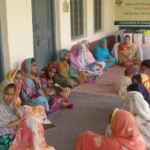
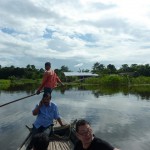

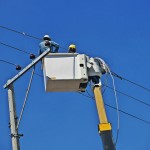


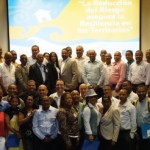
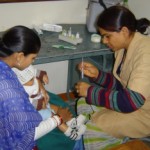 Securing Sexual and Reproductive Health of drought-affected communities in the Sindh Arid Zone, IPPF / Pakistan / Alison Lowe
Securing Sexual and Reproductive Health of drought-affected communities in the Sindh Arid Zone, IPPF / Pakistan / Alison Lowe Residents in Kobe hold a memorial ceremony on Jan. 17 to mark the day when a deadly earthquake killed more than 6,000 people. (FACEBOOK / Asiya Hamada)
Residents in Kobe hold a memorial ceremony on Jan. 17 to mark the day when a deadly earthquake killed more than 6,000 people. (FACEBOOK / Asiya Hamada)
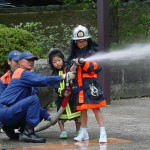








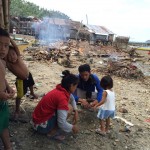

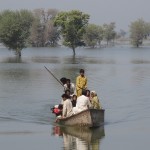
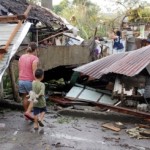





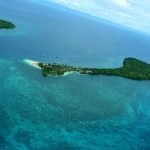




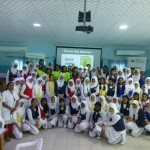



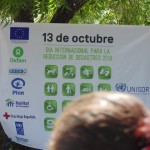

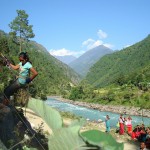

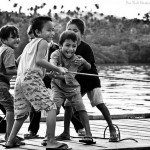


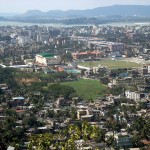
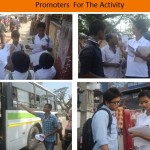

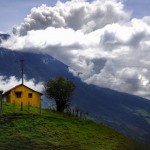
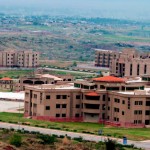

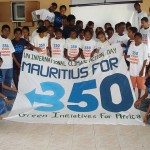






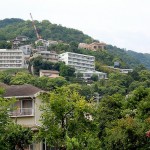

 www.hazardmap.pref.hyogo.jp
www.hazardmap.pref.hyogo.jp




